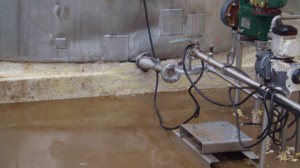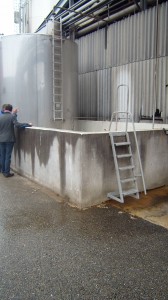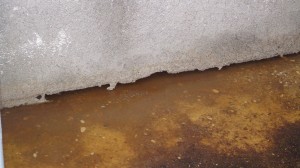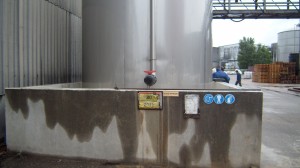Around 5 pm, a tap broke on a 40-m³ tank in a distillery, causing the leak of 3.4 tonnes of a 69% nitric acid (HNO3). This leak came to light adjacent to a full buffer tank made of Teflon (PTFE) blocking a 25-mm diameter pipeline downstream of the tank bottom valve. The acid spilled into the retention basin, attacked the protective lining composed of a polyester resin on fiberglass, crossed the low masonry wall and flowed into a sump before overflowing into the storm drain network.
The distillery watchman notified fire-fighters as well as the on-site supervisor, who immediately closed the tank bottom valve; next, the watchman and supervisor sprinkled both the retention basin and outflow through the storm drain, thus greatly diluting the effluent. The lift pumps operated adequately for a time, but nitric fumes damaged the remote-controlled float level switch, thus initiating the pumps. The acid was no longer being discharged to the neutralisation unit. Orange vapours were released. First responders set up a 500-m safety perimeter, evacuated neighbours (10 homes) and installed a water curtain to suppress the vapours. An earthen dam was erected in the ditch partially filled by the water curtain. The distillery operator neutralised the effluent using lime, with 1,200 litres being poured at the ditch intake, 800 litres downstream of the pumping station and another 1,000 litres at the retention basin inlet; 80 m³ of effluent could be rerouted and neutralised at the facility’s treatment plant. Fire-fighters wearing diving suits restarted the pumps at 9:30 pm; pumping lasted until 10 pm and the nitric acid was neutralised by 12:30 am. A water bottling company was warned of pollution risks at its extraction points. The French military Police, an elected official and a local government authority representative visited the site.
The environmental consequences were limited, as: the effluent originating from acid removal via the water curtain had been contained upstream of the earthen dam and then neutralised; the ditch had been cleaned by a specialist firm; and all remaining water had been channelled to the treatment plant.
The fastening of transfer pumps and pipelines onto the retention basin pavement using pins had perforated the anti-acid lining, causing a loss of tightness. Moreover, this lining had not been adapted to the concentration of nitric acid being stored. The characteristics of the lining’s chemical composition, as guaranteed by the resin manufacturer, called for limiting the acid concentration to 68%.
The plan operator adopted several corrective measures, namely: requesting technicians to close the tank bottom valve after each use until shutdown of the tartaric acid shop scheduled for end of June; having a specialist firm reline the retention basin with (18 k grade) stainless steel as of July; and replacing the nylon float switches with a stainless steel model.










